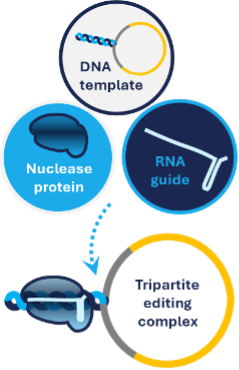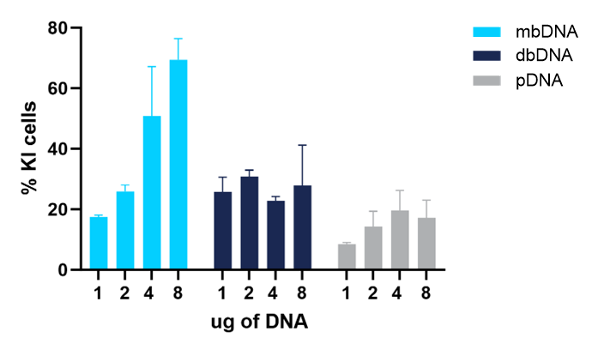Single-stranded DNA (ssDNA) offers a revolutionary template for gene editing, enhancing the precision and effectiveness of CRISPR technologies. Traditional CRISPR-based gene therapies often rely on viral vectors owing to the unavailability of high-quality, cost-effective GMP-grade, gene-length ssDNA. Addressing this gap, Touchlight's nonviral MegaBulb DNA (mbDNA) offers a high-purity, synthetic alternative that demonstrates remarkable efficiency and minimal toxicity. Touchlight is poised to meet growing demand, setting a new standard for diverse gene editing applications, including gene therapies.
DNA Templates and CRISPR Technology
Advances in CRISPR (clustered regularly interspaced short palindromic repeats) gene editing technology are revolutionizing potential applications for biopharmaceuticals. The first CRISPR/Cas9 gene-edited therapy, CASGEVY™ (exagamglogene autotemcel, co-developed by Vertex Pharmaceuticals and CRISPR Therapeutics), received approval in multiple countries last year.1 Concurrently, the broader CRISPR technology market, which includes consumables and services for a variety of sectors, such as pharmaceuticals, veterinary sciences, agriculture and biofuels, is expected to grow from $3.4 billion in 2023 to $7.1 billion by 2028, expanding at a CAGR of 15.6%.1
CRISPR technology facilitates precise genetic alterations, such as the addition of novel recombinant genes or the correction of faulty ones, offering new avenues for biotherapeutic development and cell-line engineering for diverse applications. This technology is also critical in fundamental biological research, helping elucidate complex biological pathways and disease mechanisms.
In CRISPR gene editing, an RNA “guide” (gRNA) directs the CRISPR-associated (Cas) nuclease, typically Cas9, to a specific DNA sequence. Here, the gRNA binds and instructs the nuclease to cut the DNA; after the Cas9 enzyme cuts the target sequence, the cell employs its repair mechanisms to mend the break. The two primary pathways are non-homologous end joining (NHEJ) and homology-directed repair (HDR). NHEJ is an error-prone process that often results in gene disruptions due to insertions or deletions at the cut site, which is useful for gene-silencing applications. Conversely, HDR is a precise repair mechanism that requires an available donor DNA template. Supplying such a template designed to correct or insert specific sequences at the cut site allows for accurate genetic edits, which is ideal for therapeutic gene corrections and enhancements. The choice between NHEJ and HDR defines the outcome of the edit, with NHEJ being more efficient but less precise and HDR offering exact, templated genetic modifications.
Non-viral HDR donor sequences have traditionally been delivered into cell nuclei as double-stranded DNA (dsDNA) templates, produced through fermentation in Escherichia coli. Avoiding fermentation-based impurities enhances safety and efficiency, and synthetic alternatives, like Touchlight’s enzymatically amplified dbDNA™ (doggybone DNA), are gaining favor. Free from bacterial sequences, including antibiotic resistance genes, they pose a lower risk of unwanted genomic insertions — and their minimal sequence grants them more flexibility for genes of interest (GOIs) of any size. Coupled with shorter production timelines, synthetic DNA templates offer enhanced efficiency and ease of editing.
HDR rates can be further improved by the use of single-stranded (ssDNA) templates. These are also associated with reduced toxicity and immunogenic responses compared with their double-stranded counterparts, making them particularly promising alternatives. Despite these advantages, the production of long ssDNA templates suitable for gene insertion remains a challenge; consequently, viral vectors have been the preferred replication and delivery vehicles for ssDNA in CRISPR applications owing to their high efficiency, despite the inherent safety concerns and limitations on template length.
MegaBulb DNA: A Nonviral ssDNA Solution
mbDNA represents a breakthrough in gene-editing technology as a novel, circular ssDNA template. It features a unique double-stranded hairpin that encodes the target site for the nuclease used to target the genome, enhancing its stability and efficacy (Figure 1). Developed by Touchlight, this high-purity, synthetic ssDNA template is engineered to incorporate multi-kilobase sequences, significantly surpassing the capacity limitations of traditional viral vectors.
 Figure 1. mbDNA structure and mechanism of complex formation with a guided nuclease. a) A schematic of the mbDNA molecule consisting of a short double-stranded DNA stem (~50 bp) encoding a nuclease target site and a single-stranded DNA loop encoding a gene editing template. b) Endonuclease protein and guide RNA molecule to form a targeted nuclease complex. c) mbDNA complexed with a nuclease and a guide RNA.
Figure 1. mbDNA structure and mechanism of complex formation with a guided nuclease. a) A schematic of the mbDNA molecule consisting of a short double-stranded DNA stem (~50 bp) encoding a nuclease target site and a single-stranded DNA loop encoding a gene editing template. b) Endonuclease protein and guide RNA molecule to form a targeted nuclease complex. c) mbDNA complexed with a nuclease and a guide RNA.
As a circular, single-stranded molecule, Touchlight's mbDNA significantly reduces cellular toxicity, enabling more effective on-target insertions while preserving cell viability. This feature is pivotal for therapeutic applications where cell survival, and recovery, are crucial.
Importantly, the nuclease target site on the mbDNA facilitates assembly of the guide, nuclease, and template into a tripartite editing complex. This drives efficient nuclear trafficking and further improves HDR rates. It is compatible with targeted nucleases beyond Cas9, including Cas12a, which is known for its propensity to cleave ssDNA, thus broadening its utility across different CRISPR applications. The increased editing efficiency and low toxicity profile of mbDNA not only ensures a higher proportion of cells are edited initially but also promotes faster cell recovery, leading to quicker cell expansion and growth, further boosting edited cell yields.
Touchlight’s production process for mbDNA is not only straightforward but also highly scalable, facilitating the transition from laboratory-scale experiments to industrial-scale production without compromising quality or efficiency.
Minimizing Variability
Whether for autologous treatments (using cells harvested from the patient) or allogeneic products (cells from healthy donors), a significant challenge in gene editing workflows is managing the variability between cells sourced from different individuals. These variations can lead to divergent responses to CRISPR reagents, making the editing process unreliable and posing a challenge to predicting cellular outcomes.
The differential response is most pronounced with double-stranded DNA produced through bacterial fermentation, such as plasmid. The structure and composition of such templates can be recognized by the cell as foreign, triggering an immune response and inducing cell death. Although Touchlight’s synthetic, linear, highly purified dbDNA mitigates some of these risks due to its cleaner production process, its double-stranded nature can still induce some level of immune detection.
As highly pure, synthetic ssDNA, mbDNA substantially reduces these risks. Its single-stranded nature minimizes the likelihood of being detected as a foreign invader by the cell, thereby reducing the activation of apoptotic pathways. This property of mbDNA provides a more consistent response across different cellular environments and between cells from different donors, enhancing the reliability and manufacturability of cell therapies derived from gene editing techniques.
Producing ssDNA at the Required Quality
Producing ssDNA of the requisite quality for gene editing presents significant challenges. Traditional methods are often cost-prohibitive and struggle to deliver the length, precision and purity needed for effective gene editing. Achieving milligram to gram quantities of good manufacturing practice (GMP)-compliant ssDNA within a practical timeframe has historically been near-impossible.
Touchlight has revolutionized this process at its state-of-the-art facility, which stands as the largest-capacity dedicated DNA manufacturing site globally. Touchlight’s extensive experience in enzymatic DNA synthesis, honed through the production of dbDNA, has been adeptly applied to the production of mbDNA. This method deploys similar processes and raw material supply chain to ensure robustness, high purity and fidelity in ssDNA production — as well as full sequence flexibility that enables the production of any circular ssDNA molecules. While the hairpin structure of mbDNA is optimized for guided nucleases like the Cas family used in CRISPR gene editing, this method can also be used to produce other circular ssDNA templates suitable for emerging non-CRISPR based technologies.
Touchlight routinely produces research-grade mbDNA at a scale of 0.1 mg and batches at the tens of mg scale will be available in the coming months, with GMP production in 2025. Additionally, Touchlight is pioneering novel analytical methods tailored for mbDNA — these form the cornerstone of a comprehensive quality control package, enhancing mbDNA’s application in the development of cutting-edge gene therapies.
Forging the Future of Gene Editing with mbDNA
Touchlight's mbDNA, with its novel structure and extensive application potential, is attracting significant interest as an accessible ssDNA solution providing an innovative approach to gene therapy. Numerous pharmaceutical and biotechnology firms are actively engaged with Touchlight to explore mbDNA's capabilities within their preclinical programs.
 Figure 2. mbDNA outperforms double-stranded DNA as CRISPR HDR template. EGFP-encoding mbDNA, dbDNA, or plasmid (pDNA) with homology arms to the TRAC locus and a Cas9-gRNA complex were electroporated into human primary T cells at the indicated DNA amount. During the first 24 h, the cells were treated with a cocktail of small molecules known to promote the HDR pathway. EGFP expression was measured 8 days post-electroporation to assess knock-in efficiency.
Figure 2. mbDNA outperforms double-stranded DNA as CRISPR HDR template. EGFP-encoding mbDNA, dbDNA, or plasmid (pDNA) with homology arms to the TRAC locus and a Cas9-gRNA complex were electroporated into human primary T cells at the indicated DNA amount. During the first 24 h, the cells were treated with a cocktail of small molecules known to promote the HDR pathway. EGFP expression was measured 8 days post-electroporation to assess knock-in efficiency.
Studies by these leading gene-editing teams have demonstrated that mbDNA significantly outperforms traditional HDR templates. When used in conjunction with small molecule enhancers it achieves genome repair rates of 75% in human primary T cells, rivalling the efficiencies of adeno-associated virus (AAV) vectors (Figure 2). Moreover, mbDNA has shown to provide four-fold higher HDR rates than commercially available linear ssDNA HDR templates (Figure 3). Its robust performance is consistent across different blood donors and effective across various cell types, which underscores its suitability for autologous cell therapies.
 Figure 3. mbDNA is a more effective CRIPSR HDR template than linear single-stranded DNA. mbDNA or a commercially available linear ssDNA encoding EGFP with homology arms to the TRAC locus were electroporated into human primary T cells at the indicated concentration, alongside a Cas9-gRNA complex. HDR efficiencies were measured 2 and 5 days post-electroporation and normalised to the 160 nM linear ssDNA sample measured at day 2.
Figure 3. mbDNA is a more effective CRIPSR HDR template than linear single-stranded DNA. mbDNA or a commercially available linear ssDNA encoding EGFP with homology arms to the TRAC locus were electroporated into human primary T cells at the indicated concentration, alongside a Cas9-gRNA complex. HDR efficiencies were measured 2 and 5 days post-electroporation and normalised to the 160 nM linear ssDNA sample measured at day 2.
The transformative potential of mbDNA — representing a step change in gene editing technology — is particularly exciting. Traditional gene therapies often rely on viral vectors, which, despite their efficacy, come with inherent risks, such as immunogenicity and potential insertional mutagenesis. mbDNA addresses these concerns by providing a safer, non-viral delivery method that could revolutionize gene therapy applications, enabling more complex edits and making treatments safer and more accessible.
With a proven track record of advancing DNA technologies from laboratory research to large-scale GMP production, Touchlight is ideally positioned to lead this transformation. Touchlight’s expertise in scaling up and refining the production process ensures that mbDNA will be ready to meet the growing demand for effective, non-viral gene therapies. The industry's growing recognition of mbDNA's benefits underscores its potential to be a game-changer in the development of new genome-edited therapies at the forefront of a new era of medical treatments.
References
1. CRISPR Gene Editing Therapies Market. Roots Analysis. 2024.

